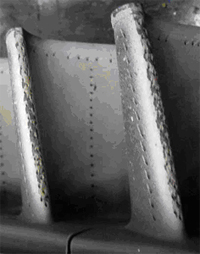Volcanic Déjà vu: How well did we do on the second try?

A little over a year after the Eyjafjallajökull eruption, we have another eruption in Iceland causing air transportation disruptions in Europe. Grímsvötn erupted on May 21, but relatively briefly.
 Figure 1. UK Met Office volcanic ash forecast for surface-FL200, FL200-FL350, and FL350-FL550.
Figure 1. UK Met Office volcanic ash forecast for surface-FL200, FL200-FL350, and FL350-FL550.  Figure 2. Damage to NASA CFM-56 engines from 7 minute exposure to unspecified volcanic ash density from 2000 Hekla eruption in Iceland. Resulted in over $3M repair costs. Source: NASA
Figure 2. Damage to NASA CFM-56 engines from 7 minute exposure to unspecified volcanic ash density from 2000 Hekla eruption in Iceland. Resulted in over $3M repair costs. Source: NASA Although ash emissions slowed after a couple of days, the ash plume was propelled above FL600. The ash clouds moved predominantly to the north and northeast. But, portions of the ash cloud traveled toward the British Isles and Scandinavia, and eventually to parts of Central Europe. As of this writing about 1200 flights have been canceled.
A year ago, there was much angst about the massive disruptions caused by Eyjafjallajökull. The debate continues about who should compensate who for damages and suffering incurred. Some valuable time was lost as organizations seemed to avoid taking any corrective actions that might be viewed as accepting some responsibility for disruptions and the resulting damages. Nonetheless, some progress was made and an exercise was conducted in April 2011, with resounding success declared at its conclusion. So, how did we do with Grímsvötn?
First thing to note is that the UK Met Office is still under attack. This time, as last time, the most vociferous and vituperous is Ryanair. The UK Met Office issued forecasts, providing cloud position and densities in 6 hour snapshots for three altitude bands (surface to FL200, FL200-FL350, and FL350-FL550). Ryanair said it flew an aircraft at FL410 and determined that there was no appreciable ash to be found. It said that the mythical red zones (denoting ash concentrations above the safe limit of 4000 micrograms per cubic meter) were a misguided invention of the UK Met Office. While its hard to know exactly what happened, it appears that the large red areas denoted on UK Met Office forecasts were in the lowest altitude band. The upper band in the UK Met Office forecast that includes FL410 showed no red areas close to the UK or mainland Europe. So, it would seem that Ryanair merely confirmed the UK Met Offices forecast in the upper altitude band. Its not uncommon for people to talk past each other in the midst of all the confusion during a crisis. Perhaps this is what happened.
A year ago, there was much angst about the massive disruptions caused by Eyjafjallajökull. The debate continues about who should compensate who for damages and suffering incurred. Some valuable time was lost as organizations seemed to avoid taking any corrective actions that might be viewed as accepting some responsibility for disruptions and the resulting damages. Nonetheless, some progress was made and an exercise was conducted in April 2011, with resounding success declared at its conclusion. So, how did we do with Grímsvötn?
First thing to note is that the UK Met Office is still under attack. This time, as last time, the most vociferous and vituperous is Ryanair. The UK Met Office issued forecasts, providing cloud position and densities in 6 hour snapshots for three altitude bands (surface to FL200, FL200-FL350, and FL350-FL550). Ryanair said it flew an aircraft at FL410 and determined that there was no appreciable ash to be found. It said that the mythical red zones (denoting ash concentrations above the safe limit of 4000 micrograms per cubic meter) were a misguided invention of the UK Met Office. While its hard to know exactly what happened, it appears that the large red areas denoted on UK Met Office forecasts were in the lowest altitude band. The upper band in the UK Met Office forecast that includes FL410 showed no red areas close to the UK or mainland Europe. So, it would seem that Ryanair merely confirmed the UK Met Offices forecast in the upper altitude band. Its not uncommon for people to talk past each other in the midst of all the confusion during a crisis. Perhaps this is what happened.
The most significant point is that, unlike the US, European regulators are still closing the airspace. In the US, based on forecast meteorological conditions (including volcanic ash), the aircraft operators are responsible for determining where they want to fly and if they should fly. Airspace normally is not closed per se. If Europe were to adopt the same approach used in US airspace, Ryanair would have to decide where and if it wanted to fly. Following the Eyjafjallajökull eruption in 2010, it appeared that Europe would adopt an approach similar to the US. But, this is a pretty fundamental shift in operational, regulatory and legal terms, so it will take some time to do if it happens.
The second thing to note is that the no-fly ash density threshold has changed from 2 mg/m3 (2000 micrograms per cubic meter) in April 2010 to 4000 micrograms per cubic meter. More specifically, in May 2010, European authorities decided that 4000 micrograms per cubic meter should be the no-fly threshold and that some time-limited flying could be done at ash densities between 2000 and 4000 micrograms per cubic meter, provided aircraft operators established a more rigorous inspection program in coordination with their engine and airframe manufacturers. Im happy to see that duration of exposure is being considered in addition to ash concentration. But, I suspect a lot more work will be needed in this area, especially as new, higher efficiency engines hit the marketplace. These new engines will run hotter and are expected to be more susceptible to volcanic ash. Also, we need to keep in mind that these thresholds arent really safety limits. In reality, these should be thought of as maintenance or economic limits. Even modest ash damage to jet engines, which might present little or no safety risk, can result in millions of dollars of overhaul expense. These expenses would be borne by aircraft operators. So, this is another good reason to allow the aircraft operator to decide where, when or if the aircraft should fly.
The second thing to note is that the no-fly ash density threshold has changed from 2 mg/m3 (2000 micrograms per cubic meter) in April 2010 to 4000 micrograms per cubic meter. More specifically, in May 2010, European authorities decided that 4000 micrograms per cubic meter should be the no-fly threshold and that some time-limited flying could be done at ash densities between 2000 and 4000 micrograms per cubic meter, provided aircraft operators established a more rigorous inspection program in coordination with their engine and airframe manufacturers. Im happy to see that duration of exposure is being considered in addition to ash concentration. But, I suspect a lot more work will be needed in this area, especially as new, higher efficiency engines hit the marketplace. These new engines will run hotter and are expected to be more susceptible to volcanic ash. Also, we need to keep in mind that these thresholds arent really safety limits. In reality, these should be thought of as maintenance or economic limits. Even modest ash damage to jet engines, which might present little or no safety risk, can result in millions of dollars of overhaul expense. These expenses would be borne by aircraft operators. So, this is another good reason to allow the aircraft operator to decide where, when or if the aircraft should fly.
Lastly, despite the relatively limited nature of the Grímsvötn event, early estimates suggest that over 1000 flights will have been canceled. Had it been more like Eyjafjallajökull in 2010, where over 100,000 flights were canceled, what would have happened? Much more needs to be done to allow all of the stakeholders to exchange and collectively evaluate critical information, interact with each other, share intent information, and develop and execute coordinated plans. As we gain a better understanding of the effects of volcanic ash density and duration of exposure on jet engines, aircraft operators will require far more accurate and dynamic information to plan and operate their flights in a way that minimizes disruptions while avoiding huge, unexpected maintenance losses. Volcanic and other disruptions usually cant be controlled, but there is so much more we could and should be doing to better prepare and cope with these difficult situations when they do happen.





.jpg)
.png)

Comments
There are no comments yet for this item
Join the discussion